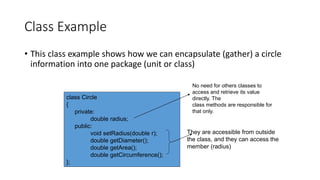[OOP - Lec 09,10,11] Class Members & their Accessing
- 1. Class Members Data Members Member Functions (Methods) Accessing Class Members Muhammad Hammad Waseem [email protected]
- 2. Object Oriented Programming • Object-oriented programming (OOP) • Encapsulates data (attributes) and functions (behavior) into packages called classes. • So, Classes are user-defined (programmer-defined) types. • Data (data members) • Functions (member functions or methods) • In other words, they are structures + functions
- 3. Classes in C++ • A class definition begins with the keyword class. • The body of the class is contained within a set of braces, { } ; (notice the semi-colon). class class_name { …. …. …. }; Class body (data member + methods) Any valid identifier
- 4. Classes in C++ • Within the body, the keywords private: and public: specify the access level of the members of the class. • the default is private. • Usually, the data members of a class are declared in the private: section of the class and the member functions are in public: section.
- 5. Classes in C++ class class_name { private: … … … public: … … … }; Public members or methods private members or methods
- 6. Classes in C++ • Member access specifiers • public: • can be accessed outside the class directly. • private: • Accessible only to member functions of class • Private members and methods are for internal use only.
- 7. Class Example • This class example shows how we can encapsulate (gather) a circle information into one package (unit or class) class Circle { private: double radius; public: void setRadius(double r); double getDiameter(); double getArea(); double getCircumference(); }; No need for others classes to access and retrieve its value directly. The class methods are responsible for that only. They are accessible from outside the class, and they can access the member (radius)
- 8. Special Member Functions • Constructor: • Public function member • called when a new object is created (instantiated). • Initialize data members. • Same name as class • No return type • Several constructors • Function overloading
- 9. Special Member Functions class Circle { private: double radius; public: Circle(); Circle(int r); void setRadius(double r); double getDiameter(); double getArea(); double getCircumference(); }; Constructor with no argument Constructor with one argument
- 10. Implementing class methods • Class implementation: writing the code of class methods. • There are two ways: 1. Member functions defined inside class MemberFunctionName( ) { … } 2. Member functions defined outside class ReturnType ClassName::MemberFunctionName( ) { … }
- 11. Implementing class methods 1. Member functions defined inside class • Do not need scope resolution operator, class name; class Circle { private: double radius; public: Circle() { radius = 0.0;} Circle(int r); void setRadius(double r){radius = r;} double getDiameter(){ return radius *2;} double getArea(); double getCircumference(); }; Defined inside class
- 12. Defining Member Functions outside Class • The member function of a class can also be defined outside the class. • The declaration of member functions is specified within the class and function definition is specified outside the class. • The scope resolution operator :: is used in function declaration if the function is defined outside the class.
- 13. Syntax • The syntax of defining member function outside the class is as follows: Return_type Class_name:: function_name(params) { Function body } • Return_type • It indicates the type of value to be returned by the function. • Class_name • It indicates the name of class to which the function belongs. • :: • It is the scope resolution operator to define member function outside the class. • function_name • It is the name of the member function to be defined. • Function body • It is the body of the function.
- 14. class Circle { private: double radius; public: Circle() { radius = 0.0;} Circle(int r); void setRadius(double r){radius = r;} double getDiameter(){ return radius *2;} double getArea(); double getCircumference(); }; Circle::Circle(int r) { radius = r; } double Circle::getArea() { return radius * radius * (22.0/7); } double Circle:: getCircumference() { return 2 * radius * (22.0/7); Defined outside class
- 15. Accessing Class Members • Operators to access class members • Identical to those for structs • Dot member selection operator (.) • Arrow member selection operator (->) • Pointers
- 16. class Circle { private: double radius; public: Circle() { radius = 0.0;} Circle(int r); void setRadius(double r){radius = r;} double getDiameter(){ return radius *2;} double getArea(); double getCircumference(); }; Circle::Circle(int r) { radius = r; } double Circle::getArea() { return radius * radius * (22.0/7); } double Circle:: getCircumference() { return 2 * radius * (22.0/7); } void main() { Circle c1,c2(7); cout<<“The area of c1:” <<c1.getArea()<<“n”; //c1.raduis = 5;//syntax error c1.setRadius(5); cout<<“The circumference of c1:” << c1.getCircumference()<<“n”; cout<<“The Diameter of c2:” <<c2.getDiameter()<<“n”; } The first constructor is called The second constructor is called Since radius is a private class data member
- 17. class Circle { private: double radius; public: Circle() { radius = 0.0;} Circle(int r); void setRadius(double r){radius = r;} double getDiameter(){ return radius *2;} double getArea(); double getCircumference(); }; Circle::Circle(int r) { radius = r; } double Circle::getArea() { return radius * radius * (22.0/7); } double Circle:: getCircumference() { return 2 * radius * (22.0/7); } void main() { Circle c(7); Circle *cp1 = &c; Circle *cp2 = new Circle(7); cout<<“The are of cp2:” <<cp2->getArea(); }

















